Development and Characterization of Thiolated Cyclodextrin-Based Nanoparticles for Topical Delivery of Minoxidil
Abstract
1. Introduction
2. Materials and Methods
2.1. Materials
2.2. Method
2.2.1. Oxidation
2.2.2. Conjugation of Aldo-β-CD with Cysteamine HCl
2.3. Encapsulation of MXD
2.4. Preparation of Nanoparticles
2.5. Thiol Group Determination and Estimation of Disulfide Content
2.6. Surface Properties and Physical Characterization of Inclusion Complexes and Nanoparticles
2.7. Scanning Electron Microscopy for Surface Properties of Nanoparticles
2.8. Zeta-Potential Measurements
2.9. Dissolution Study
2.10. In Vitro Evaluation of Adhesion Properties on Human Hairs
2.11. Skin Tolerance Test
2.12. Drug Uptake through Skin
2.13. Statistical Data Analysis
3. Results and Discussion
3.1. Characterization of β-CD-Cys Derivatives
3.2. Determination of Thiol Group and Disulfide Bond Contents
3.3. FTIR Spectral Analysis of Thio-β-CD
3.4. Characterization of Surface Properties and Potential Charges of NPs
3.5. Drug Dissolution Studies
3.6. In Vitro Evaluation of Adhesion Properties on Human Hairs
3.7. Skin Tolerance Test
3.8. MXD Uptake through Skin
4. Conclusions
Author Contributions
Funding
Institutional Review Board Statement
Informed Consent Statement
Data Availability Statement
Acknowledgments
Conflicts of Interest
References
- Nagai, N.; Iwai, Y.; Sakamoto, A.; Otake, H.; Oaku, Y.; Abe, A.; Nagahama, T. Drug Delivery System Based On Minoxidil Nanoparticles Promotes Hair Growth In C57BL/6 Mice. Int. J. Nanomed. 2019, 14, 7921. [Google Scholar] [CrossRef]
- Yang, G.; Chen, G.; Gu, Z. Transdermal Drug Delivery for Hair Regrowth. Mol. Pharm. 2020, 18, 483–490. [Google Scholar] [CrossRef]
- Tricarico, D.; Maqoud, F.; Curci, A.; Camerino, G.; Zizzo, N.; Denora, N.; Cutrignelli, A.; Laquintana, V.; Lopalco, A.; la Forgia, F. Characterization of minoxidil/hydroxypropyl-β-cyclodextrin inclusion complex in aqueous alginate gel useful for alopecia management: Efficacy evaluation in male rat. Eur. J. Pharm. Biopharm. 2018, 122, 146–157. [Google Scholar] [CrossRef]
- Chandrashekar, B.; Nandhini, T.; Vasanth, V.; Sriram, R.; Navale, S. Topical minoxidil fortified with finasteride: An account of maintenance of hair density after replacing oral finasteride. Indian Dermatol. Online J. 2015, 6, 17. [Google Scholar] [CrossRef]
- Santos, A.C.; Pereira-Silva, M.; Guerra, C.; Costa, D.; Peixoto, D.; Pereira, I.; Pita, I.; Ribeiro, A.J.; Veiga, F. Topical Minoxidil-Loaded Nanotechnology Strategies for Alopecia. Cosmetics 2020, 7, 21. [Google Scholar] [CrossRef]
- Mali, N.; Darandale, S.; Vavia, P. Niosomes as a vesicular carrier for topical administration of minoxidil: Formulation and in vitro assessment. Drug Deliv. Transl. Res. 2013, 3, 587–592. [Google Scholar] [CrossRef]
- Lopedota, A.; Cutrignelli, A.; Denora, N.; Laquintana, V.; Lopalco, A.; Selva, S.; Ragni, L.; Tongiani, S.; Franco, M. New ethanol and propylene glycol free gel formulations containing a minoxidil-methyl-β-cyclodextrin complex as promising tools for alopecia treatment. Drug Dev. Ind. Pharm. 2015, 41, 728–736. [Google Scholar] [CrossRef]
- Suchonwanit, P.; Thammarucha, S.; Leerunyakul, K. Minoxidil and its use in hair disorders: A review. Drug Des. Dev. Ther. 2019, 13, 2777. [Google Scholar] [CrossRef]
- Herrmann, S.; Daniels, R.; Lunter, D. Methods for the determination of the substantivity of topical formulations. Pharm. Dev. Technol. 2017, 22, 487–491. [Google Scholar] [CrossRef]
- Sakamoto, K.; Lochhead, R.; Maibach, H.; Yamashita, Y. Cosmetic Science and Technology: Theoretical Principles and Applications; Elsevier: Amsterdam, The Netherlands, 2017. [Google Scholar]
- Ijaz, M.; Ahmad, M.; Akhtar, N.; Laffleur, F.; Bernkop-Schnürch, A. Thiolated α-cyclodextrin: The invisible choice to prolong ocular drug residence time. J. Pharm. Sci. 2016, 105, 2848–2854. [Google Scholar] [CrossRef]
- Ijaz, M.; Matuszczak, B.; Rahmat, D.; Mahmood, A.; Bonengel, S.; Hussain, S.; Huck, C.W.; Bernkop-Schnürch, A. Synthesis and characterization of thiolated β-cyclodextrin as a novel mucoadhesive excipient for intra-oral drug delivery. Carbohydr. Polym. 2015, 132, 187–195. [Google Scholar] [CrossRef]
- Ijaz, M.; Griessinger, J.A.; Mahmood, A.; Laffleur, F.; Bernkop-Schnürch, A. Thiolated cyclodextrin: Development of a mucoadhesive vaginal delivery system for acyclovir. J. Pharm. Sci. 2016, 105, 1714–1720. [Google Scholar] [CrossRef]
- Rahmat, D.; Sakloetsakun, D.; Shahnaz, G.; Perera, G.; Kaindl, R.; Bernkop-Schnürch, A. Design and synthesis of a novel cationic thiolated polymer. Int. J. Pharm. 2011, 411, 10–17. [Google Scholar] [CrossRef]
- Binder, C.M.; Dixon, D.D.; Almaraz, E.; Tius, M.A.; Singaram, B. A simple procedure for C–C bond cleavage of aromatic and aliphatic epoxides with aqueous sodium periodate under ambient conditions. Tetrahedron Lett. 2008, 49, 2764–2767. [Google Scholar] [CrossRef][Green Version]
- Wang, J.-h.; Cai, Z. Investigation of inclusion complex of miconazole nitrate with β-cyclodextrin. Carbohydr. Polym. 2008, 72, 255–260. [Google Scholar] [CrossRef]
- Liu, F.; Majeed, H.; Antoniou, J.; Li, Y.; Ma, Y.; Yokoyama, W.; Ma, J.; Zhong, F. pH and temperature stability of (−)-epigallocatechin-3-gallate-β-cyclodextrin inclusion complex-loaded chitosan nanoparticles. Carbohydr. Polym. 2016, 149, 340–347. [Google Scholar] [CrossRef]
- Hombach, J.; Palmberger, T.F.; Bernkop-Schnürch, A. Development and in vitro evaluation of a mucoadhesive vaginal delivery system for nystatin. J. Pharm. Sci. 2009, 98, 555–564. [Google Scholar] [CrossRef]
- Iqbal, J.; Sarti, F.; Perera, G.; Bernkop-Schnürch, A. Development and in vivo evaluation of an oral drug delivery system for paclitaxel. Biomaterials 2011, 32, 170–175. [Google Scholar] [CrossRef]
- Sun, J.; Zhou, S.; Hou, P.; Yang, Y.; Weng, J.; Li, X.; Li, M. Synthesis and characterization of biocompatible Fe3O4 nanoparticles. J. Biomed. Mater. Res. Part A 2007, 80, 333–341. [Google Scholar] [CrossRef]
- Choi, J.; Kim, H.; Choi, J.; Oh, S.M.; Park, J.; Park, K. Skin corrosion and irritation test of sunscreen nanoparticles using reconstructed 3D human skin model. Environ. Health Toxicol. 2014, 29, e2014004. [Google Scholar] [CrossRef]
- Asim, M.H.; Ijaz, M.; Mahmood, A.; Knoll, P.; Jalil, A.; Arshad, S.; Bernkop-Schnürch, A. Thiolated cyclodextrins: Mucoadhesive and permeation enhancing excipients for ocular drug delivery. Int. J. Pharm. 2021, 599, 120451. [Google Scholar] [CrossRef]
- Ferreira, L.; Mascarenhas-Melo, F.; Rabaça, S.; Mathur, A.; Sharma, A.; Giram, P.S.; Pawar, K.D.; Rahdar, A.; Raza, F.; Veiga, F. Cyclodextrin-based dermatological formulations: Dermopharmaceutical and cosmetic applications. Colloids Surf. B Biointerfaces 2022, 221, 113012. [Google Scholar] [CrossRef]
- Griesser, J.; Hetényi, G.; Bernkop-Schnürch, A. Thiolated hyaluronic acid as versatile Mucoadhesive polymer: From the chemistry behind to product developments—What are the capabilities? Polymers 2018, 10, 243. [Google Scholar] [CrossRef]
- Horvat, G.; Pantić, M.; Knez, Ž.; Novak, Z. Encapsulation and drug release of poorly water soluble nifedipine from bio-carriers. J. Non-Cryst. Solids 2018, 481, 486–493. [Google Scholar] [CrossRef]
- Budai-Szűcs, M.; Kiss, E.L.; Szilágyi, B.Á.; Szilágyi, A.; Gyarmati, B.; Berkó, S.; Kovács, A.; Horvát, G.; Aigner, Z.; Soós, J. Mucoadhesive cyclodextrin-modified thiolated poly (aspartic acid) as a potential ophthalmic drug delivery system. Polymers 2018, 10, 199. [Google Scholar] [CrossRef]
- Horstmann, M.; Müller, W.; Asmussen, B. Principles of skin adhesion and methods for measuring adhesion of transdermal systems. Drugs Pharm. Sci. 1999, 98, 175–196. [Google Scholar]
- Alsalhi, W.; Alalola, A.; Randolph, M.; Gwillim, E.; Tosti, A. Novel drug delivery approaches for the management of hair loss. Expert Opin. Drug Deliv. 2020, 17, 287–295. [Google Scholar] [CrossRef]
- Grießinger, J.A.; Bonengel, S.; Partenhauser, A.; Ijaz, M.; Bernkop-Schnürch, A. Thiolated polymers: Evaluation of their potential as dermoadhesive excipients. Drug Dev. Ind. Pharm. 2017, 43, 204–212. [Google Scholar] [CrossRef]
- Khurana, S.; Bedi, P.; Jain, N. Preparation and evaluation of solid lipid nanoparticles based nanogel for dermal delivery of meloxicam. Chem. Phys. Lipids 2013, 175, 65–72. [Google Scholar] [CrossRef]
- Doktorovova, S.; Kovačević, A.B.; Garcia, M.L.; Souto, E.B. Preclinical safety of solid lipid nanoparticles and nanostructured lipid carriers: Current evidence from in vitro and in vivo evaluation. Eur. J. Pharm. Biopharm. 2016, 108, 235–252. [Google Scholar] [CrossRef]
- Hu, Y.; Wang, W.; Xu, L.; Yu, D. Surface modification of keratin fibers through step-growth dithiol-diacrylate thiol-ene click reactions. Mater. Lett. 2016, 178, 159–162. [Google Scholar] [CrossRef]
- Leichner, C.; Steinbring, C.; Baus, R.A.; Baecker, D.; Gust, R.; Bernkop-Schnürch, A. Reactive keratin derivatives: A promising strategy for covalent binding to hair. J. Colloid Interface Sci. 2019, 534, 533–541. [Google Scholar] [CrossRef]
- Li, B.; Sun, Y.; Yao, J.; Wu, H.; Shen, Y.; Zhi, C.; Li, J. An environment-friendly chemical modification method for thiol groups on polypeptide macromolecules to improve the performance of regenerated keratin materials. Mater. Des. 2022, 217, 110611. [Google Scholar] [CrossRef]
- Al Mahrooqi, J.H.; Khutoryanskiy, V.V.; Williams, A.C. Thiolated and PEGylated silica nanoparticle delivery to hair follicles. Int. J. Pharm. 2021, 593, 120130. [Google Scholar] [CrossRef]
- Mishra, P.; Handa, M.; Ujjwal, R.R.; Singh, V.; Kesharwani, P.; Shukla, R. Potential of nanoparticulate based delivery systems for effective management of alopecia. Colloids Surf. B Biointerfaces 2021, 208, 112050. [Google Scholar] [CrossRef]
- Kim, J.-C.; Lee, M.-H.; Rang, M.-J. Minoxidil-containing dosage forms: Skin retention and after-rinsing hair-growth promotion. Drug Deliv. 2003, 10, 119–123. [Google Scholar] [CrossRef][Green Version]
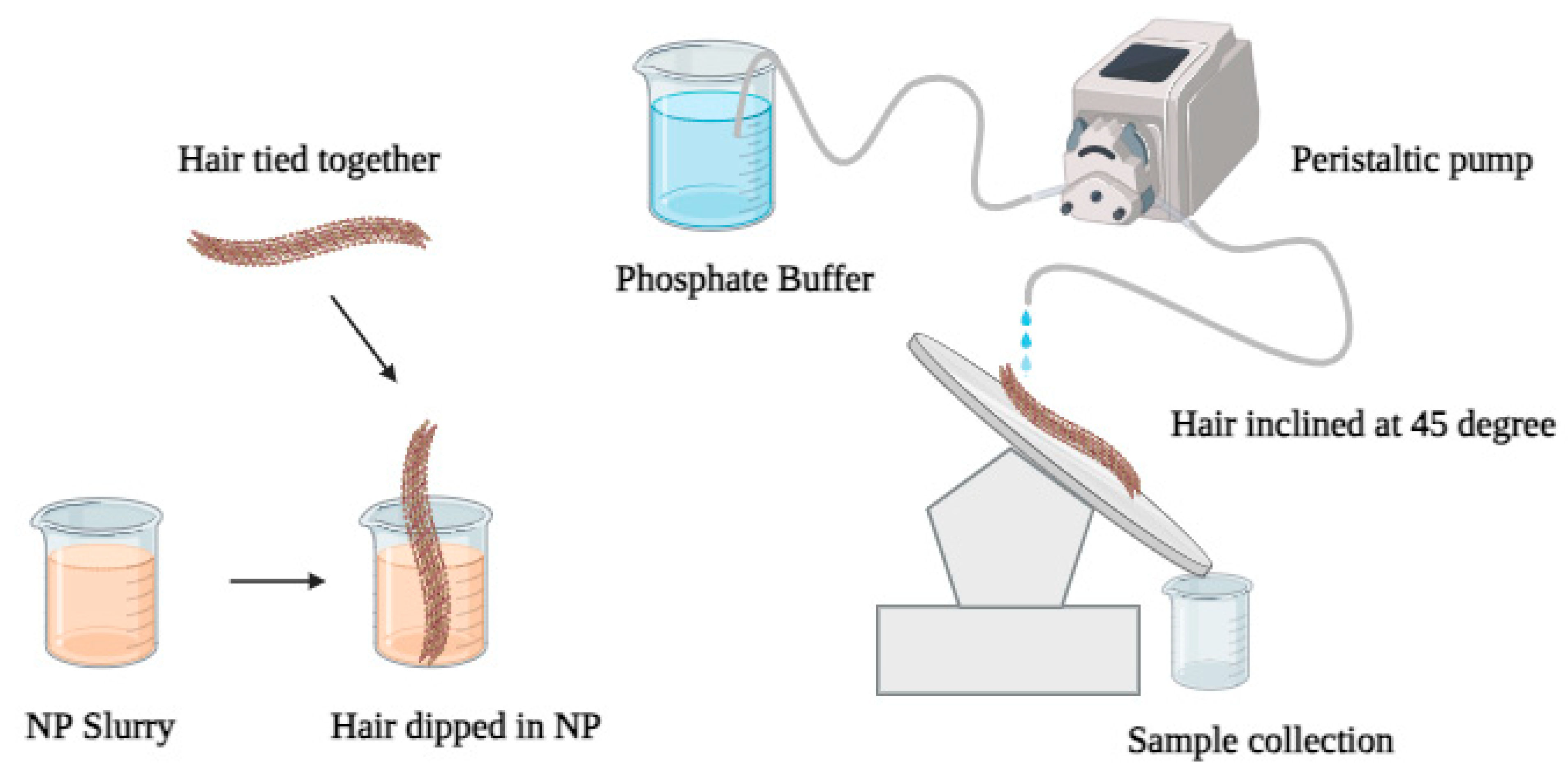
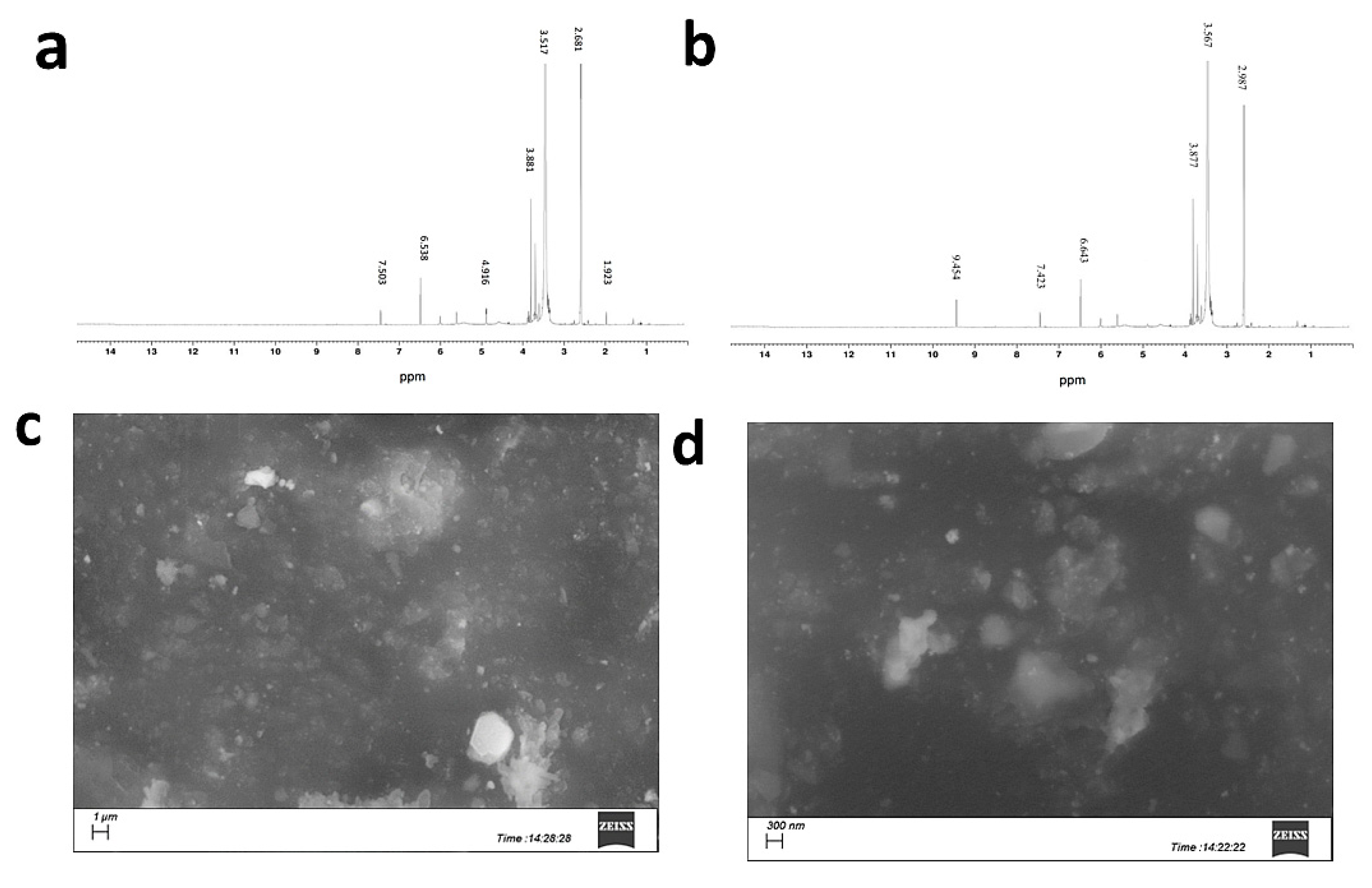
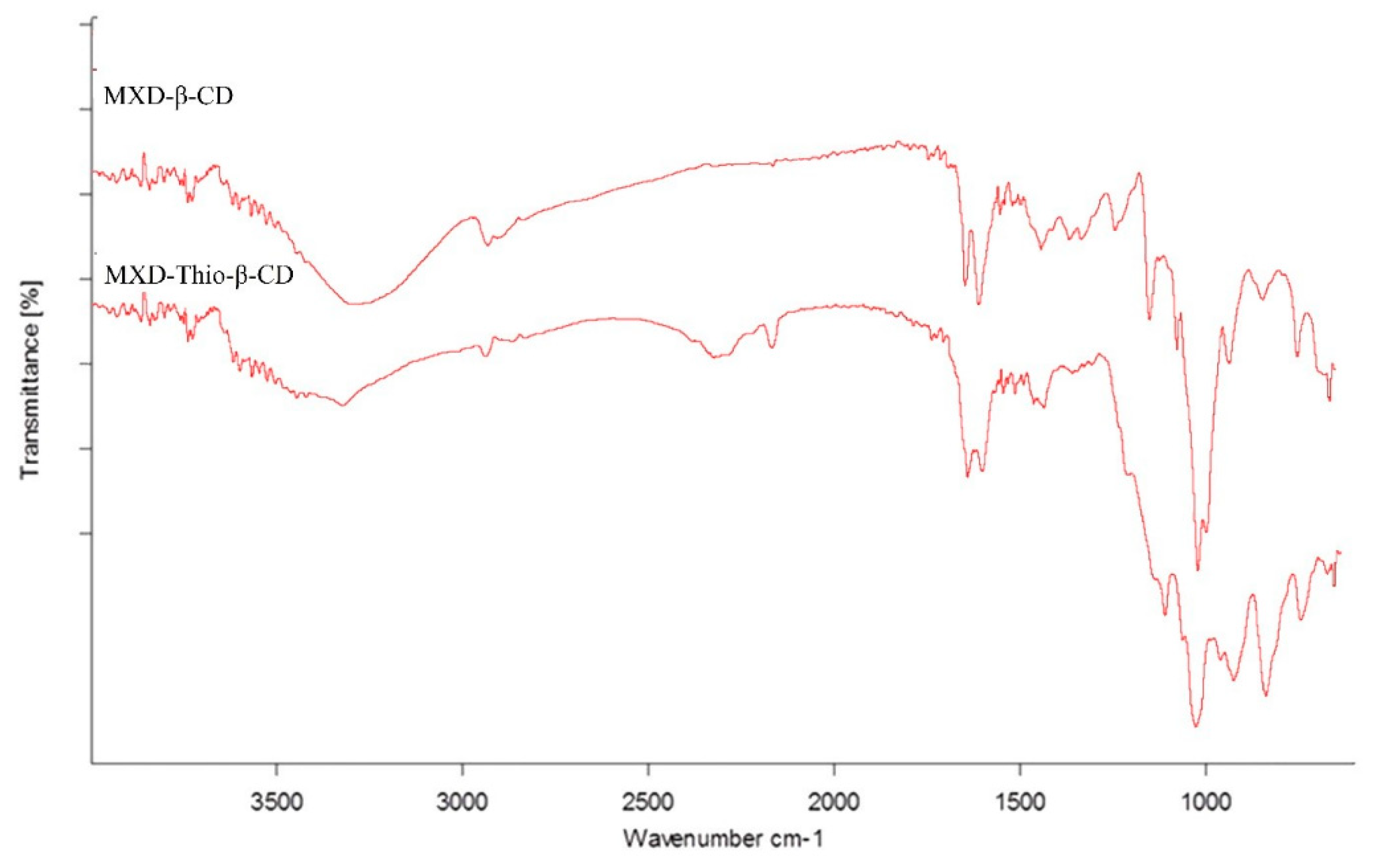

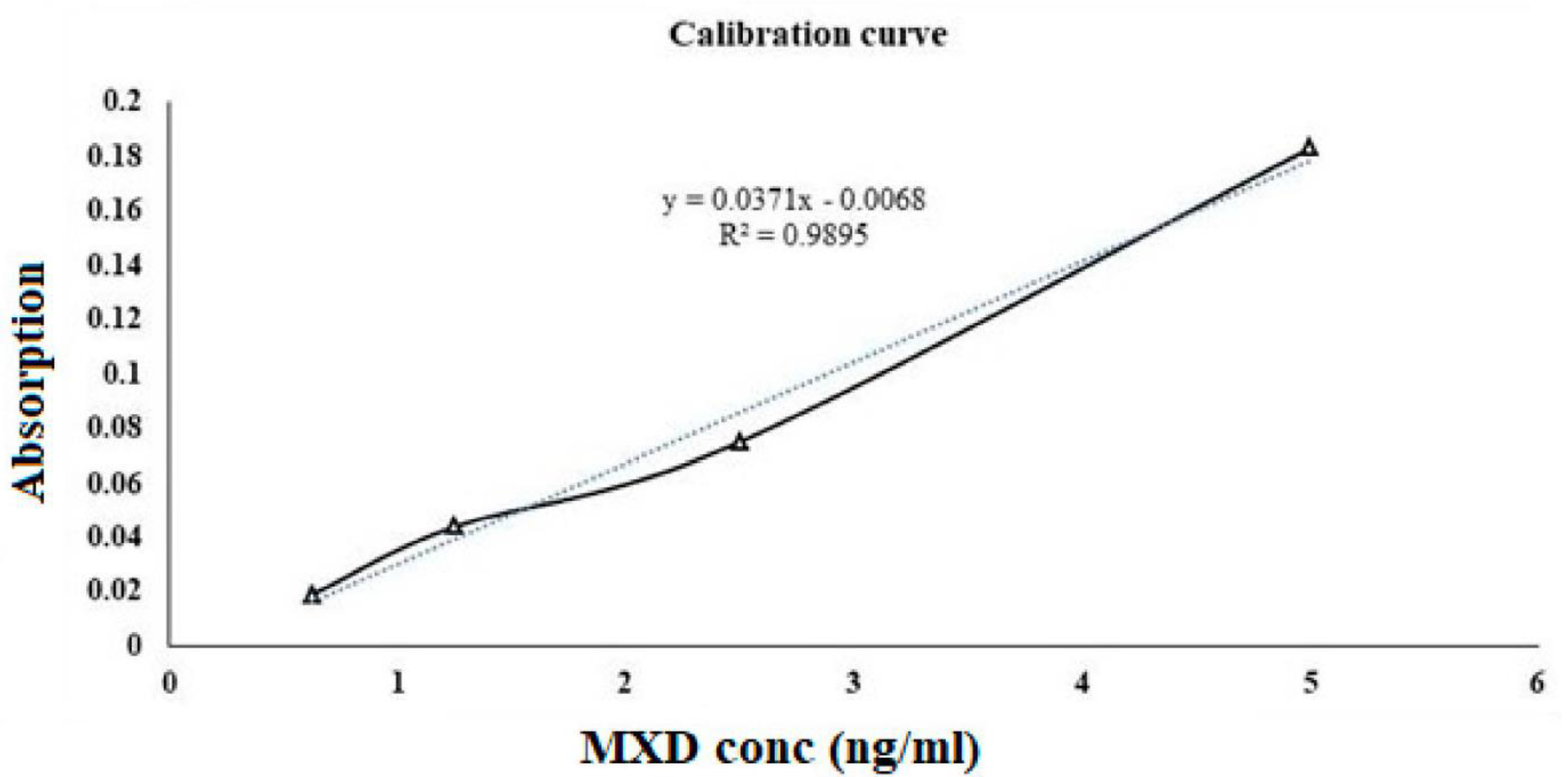
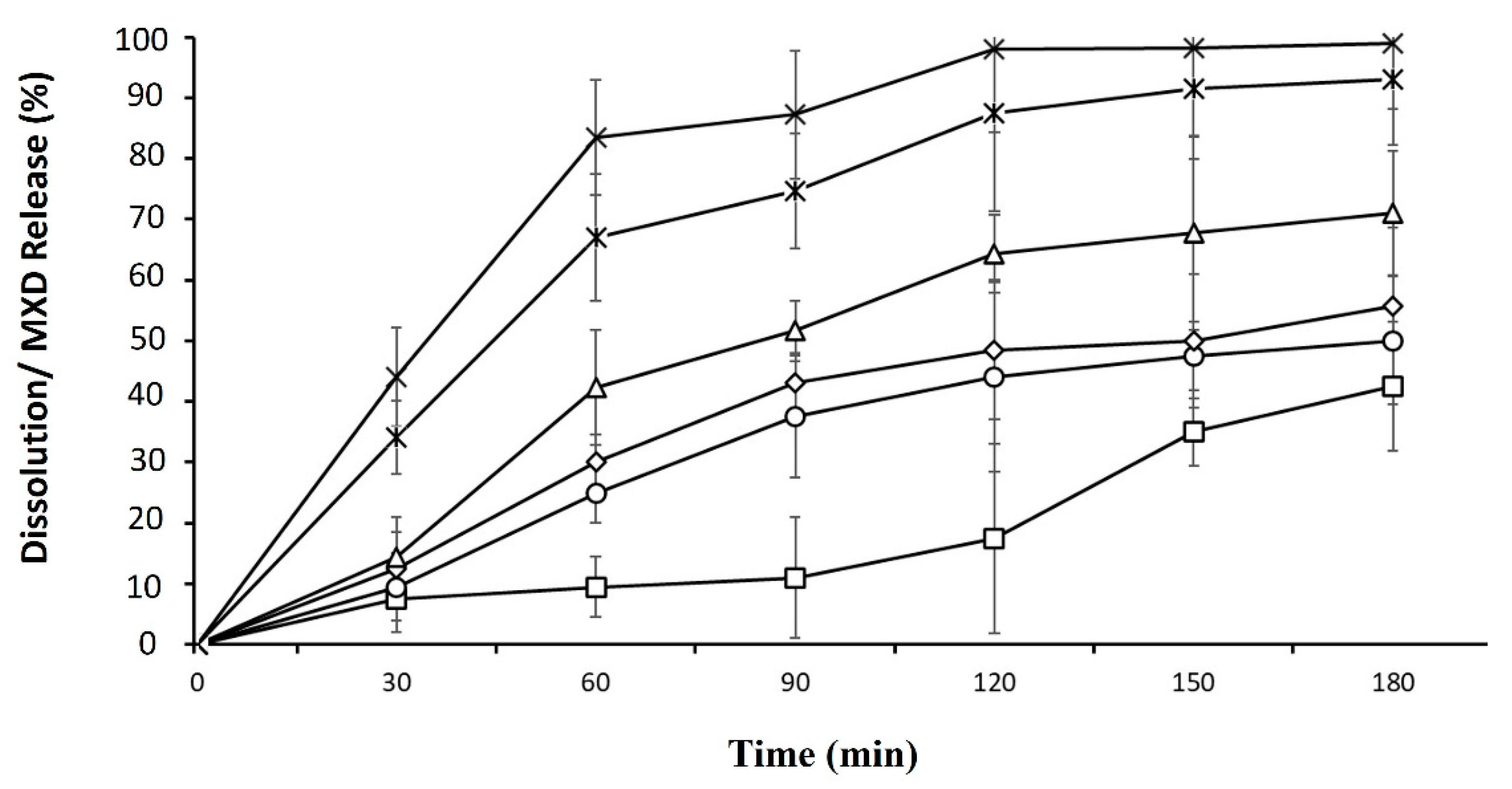
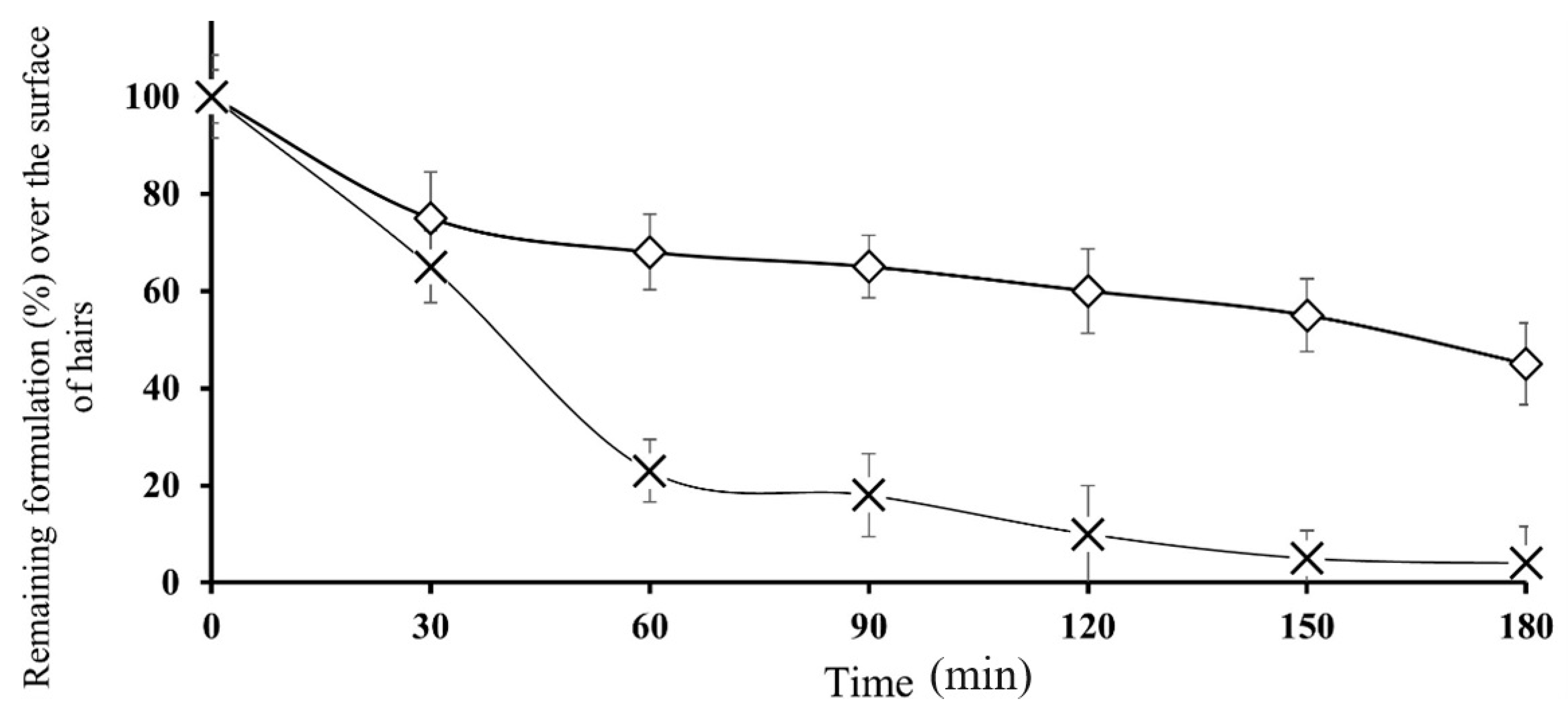
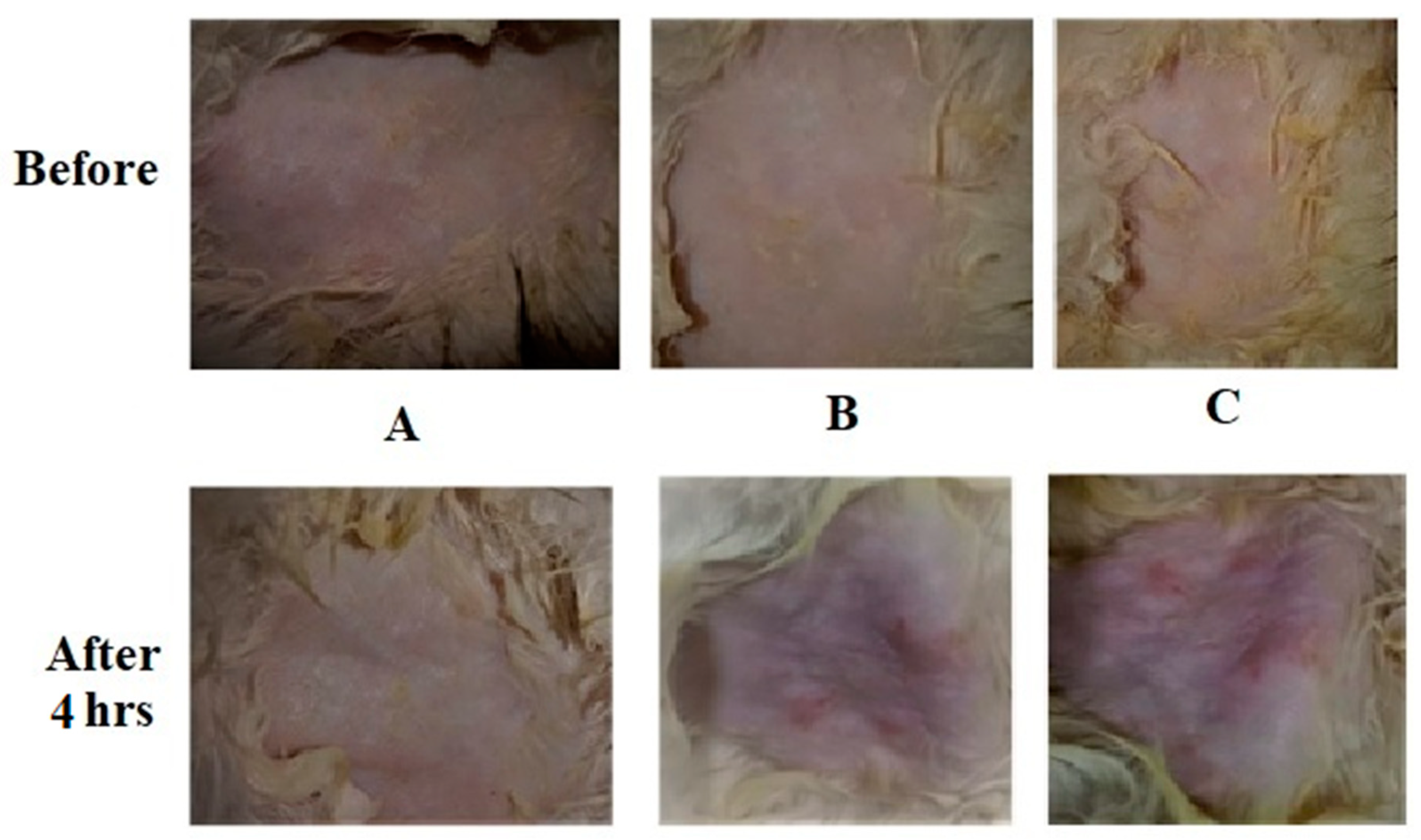
| Name | MXD Encapsulated with CDs | Chitosan | TPP |
|---|---|---|---|
| Thio-NP-1 | 10 mg/mL Thio-β-CD | 15 mg | 3 mg/mL |
| Thio-NP-2 | 20 mg/mL Thio-β-CD | 15 mg | 3 mg/mL |
| Thio-NP-3 | 30 mg/mL Thio-β-CD | 15 mg | 3 mg/mL |
| Thio-NP-4 | 40 mg/mL Thio-β-CD | 15 mg | 3 mg/mL |
| Thio-NP-5 | 50 mg/mL Thio-β-CD | 15 mg | 3 mg/mL |
| Blank-NP | 30 mg/mL β-CD | 15 mg | 3 mg/mL |
| β-CD (g) | NaIO4 (g) | Cysteamine (g) | NaCNBH3 (g) | Thiol Group (μmol/g) | (-S-S- Bonds (μmol/g) | |
|---|---|---|---|---|---|---|
| Thio-β-CD | 1 | 0.3 | 0.25 | 3 | 1804.68 ± 25 | 902.34 ± 25 |
| Formulation | Dermal Accumulation | Transdermal Recovery | Follicular Penetration |
|---|---|---|---|
| Free MXD | 1.34 ± 0.02% | 5.56 ± 1.03% | 1.12 ± 0.23% |
| Thiolated NP | 13.56 ± 0.12% | 7.35 ± 1.67% | 1.56 ± 0.57% |
| Blank NP | 4.24 ± 0.15% | 3.56 ± 0.34% | 8.45 ± 2.69% |
Disclaimer/Publisher’s Note: The statements, opinions and data contained in all publications are solely those of the individual author(s) and contributor(s) and not of MDPI and/or the editor(s). MDPI and/or the editor(s) disclaim responsibility for any injury to people or property resulting from any ideas, methods, instructions or products referred to in the content. |
© 2023 by the authors. Licensee MDPI, Basel, Switzerland. This article is an open access article distributed under the terms and conditions of the Creative Commons Attribution (CC BY) license (https://creativecommons.org/licenses/by/4.0/).
Share and Cite
Akhtar, A.; Waqas, M.K.; Mahmood, A.; Tanvir, S.; Hussain, T.; Kazi, M.; Ijaz, M.; Asim, M.H. Development and Characterization of Thiolated Cyclodextrin-Based Nanoparticles for Topical Delivery of Minoxidil. Pharmaceutics 2023, 15, 2716. https://doi.org/10.3390/pharmaceutics15122716
Akhtar A, Waqas MK, Mahmood A, Tanvir S, Hussain T, Kazi M, Ijaz M, Asim MH. Development and Characterization of Thiolated Cyclodextrin-Based Nanoparticles for Topical Delivery of Minoxidil. Pharmaceutics. 2023; 15(12):2716. https://doi.org/10.3390/pharmaceutics15122716
Chicago/Turabian StyleAkhtar, Ammara, Muhammad Khurram Waqas, Arshad Mahmood, Saira Tanvir, Talib Hussain, Mohsin Kazi, Muhammad Ijaz, and Mulazim Hussain Asim. 2023. "Development and Characterization of Thiolated Cyclodextrin-Based Nanoparticles for Topical Delivery of Minoxidil" Pharmaceutics 15, no. 12: 2716. https://doi.org/10.3390/pharmaceutics15122716
APA StyleAkhtar, A., Waqas, M. K., Mahmood, A., Tanvir, S., Hussain, T., Kazi, M., Ijaz, M., & Asim, M. H. (2023). Development and Characterization of Thiolated Cyclodextrin-Based Nanoparticles for Topical Delivery of Minoxidil. Pharmaceutics, 15(12), 2716. https://doi.org/10.3390/pharmaceutics15122716









